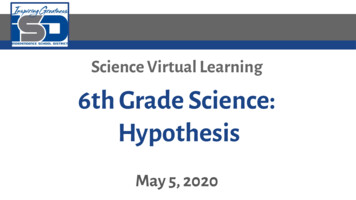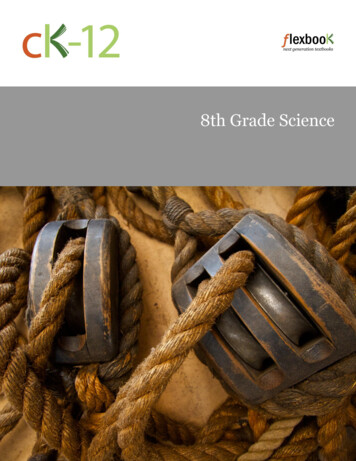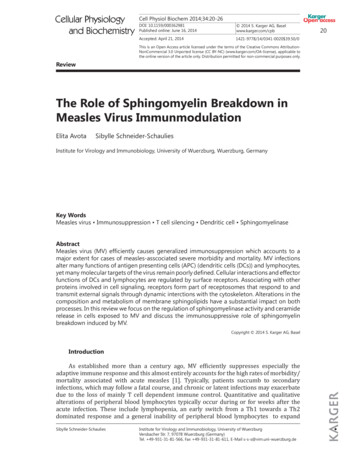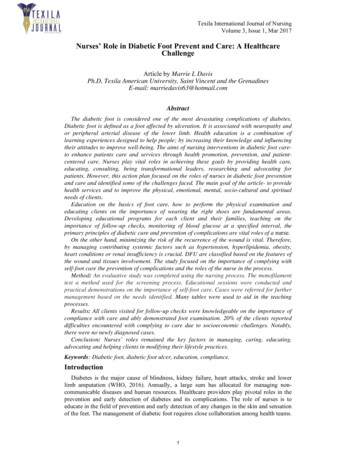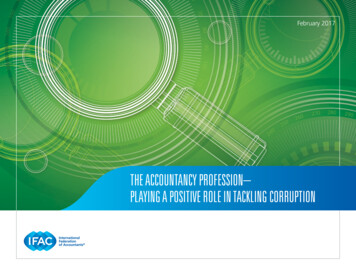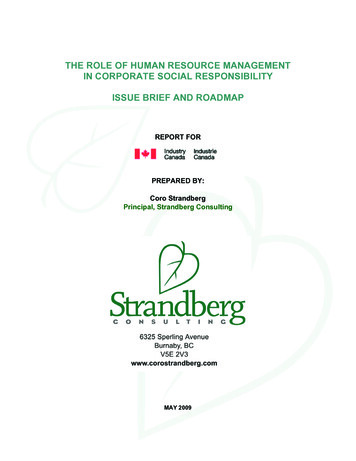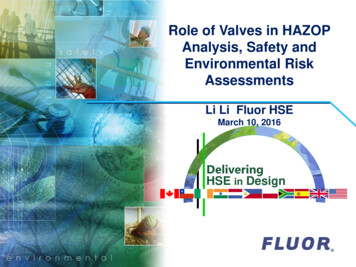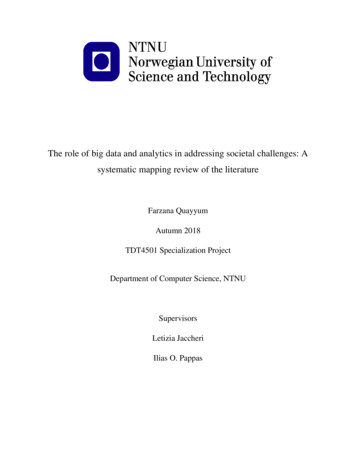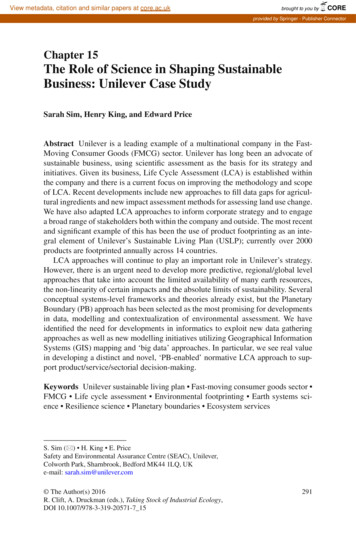
Transcription
View metadata, citation and similar papers at core.ac.ukbrought to you byCOREprovided by Springer - Publisher ConnectorChapter 15The Role of Science in Shaping SustainableBusiness: Unilever Case StudySarah Sim, Henry King, and Edward PriceAbstract Unilever is a leading example of a multinational company in the FastMoving Consumer Goods (FMCG) sector. Unilever has long been an advocate ofsustainable business, using scientific assessment as the basis for its strategy andinitiatives. Given its business, Life Cycle Assessment (LCA) is established withinthe company and there is a current focus on improving the methodology and scopeof LCA. Recent developments include new approaches to fill data gaps for agricultural ingredients and new impact assessment methods for assessing land use change.We have also adapted LCA approaches to inform corporate strategy and to engagea broad range of stakeholders both within the company and outside. The most recentand significant example of this has been the use of product footprinting as an integral element of Unilever’s Sustainable Living Plan (USLP); currently over 2000products are footprinted annually across 14 countries.LCA approaches will continue to play an important role in Unilever’s strategy.However, there is an urgent need to develop more predictive, regional/global levelapproaches that take into account the limited availability of many earth resources,the non-linearity of certain impacts and the absolute limits of sustainability. Severalconceptual systems-level frameworks and theories already exist, but the PlanetaryBoundary (PB) approach has been selected as the most promising for developmentsin data, modelling and contextualization of environmental assessment. We haveidentified the need for developments in informatics to exploit new data gatheringapproaches as well as new modelling initiatives utilizing Geographical InformationSystems (GIS) mapping and ‘big data’ approaches. In particular, we see real valuein developing a distinct and novel, ‘PB-enabled’ normative LCA approach to support product/service/sectorial decision-making.Keywords Unilever sustainable living plan Fast-moving consumer goods sector FMCG Life cycle assessment Environmental footprinting Earth systems science Resilience science Planetary boundaries Ecosystem servicesS. Sim (*) H. King E. PriceSafety and Environmental Assurance Centre (SEAC), Unilever,Colworth Park, Sharnbrook, Bedford MK44 1LQ, UKe-mail: sarah.sim@unilever.com The Author(s) 2016R. Clift, A. Druckman (eds.), Taking Stock of Industrial Ecology,DOI 10.1007/978-3-319-20571-7 15291
2921S. Sim et al.IntroductionUnilever is a Fast Moving Consumer Goods (FMCG) company with over 400brands, operations in nearly 100 countries and sales in nearly every country in theworld. Our products (foods, beverages, ice cream, home and personal care) are used2 billion times a day in over half the households on the planet. Our strategy for sustainable growth sets out a vision for leveraging this global reach to improve healthand well-being, reduce environmental impacts and enhance livelihoods. Unileverhas long been a pioneer of sustainability, and throughout this journey, science hasbeen the foundation for the company’s sustainability strategy and initiatives. Assuch, the focus of this chapter is not the business case for sustainability in Unilever(which can be found in Bell (2013a, b); Lingard (2012)), but an illustration of howscience has helped inform and shape the company’s thinking on sustainability so farand also how we will continue to use science to help us think about futurechallenges.To date, Unilever has relied on scientific methods based around Life CycleAssessment (LCA) to guide and inform our sustainability decision-making and suchapproaches will continue to have an important role to play. However, LCA does notaddress all relevant environmental impacts; nor does it deal with each impact category in an equally robust way. Therefore, there is an urgent need to develop morepredictive approaches that take into account the limited availability of manyresources, the non-linearity of certain impacts and the absolute nature of sustainability as articulated in the planetary boundary concept.2The Journey So FarLife cycle assessment (LCA) is the preferred tool for many organizations to helpthem understand the impacts and performance of their products and services in arigorous and scientific manner (Baitz et al. 2013). The LCA methodology was codified in the late 1980s/early 1990s through the work of SETAC and ISO. However,LCA is not a static tool and it is continually being evolved and improved to reflectnew science and to expand the robustness and scope of the environmental impactassessment.The flexibility of the LCA concept is one of its strengths; in Unilever, we haveexploited this feature and in doing so helped inform and shape our environmentalstrategy over the past 20 years (Fig. 15.1). In the mid-1990s, Unilever developed theOverall Business Impact Assessment (OBIA) approach (Clift and Wright 2000) asa means to scientifically identify our priority environmental impacts and to informthe selection of key sustainability programs. Unlike traditional LCA which focuseson single systems, usually products, the OBIA approach can be used to assess theeffects of all the individual products produced by a business for a given period oftime, typically 1 year. The potential environmental impacts of the business are
15The Role of Science in Shaping Sustainable Business: Unilever Case StudyDefining nability inBrands/marketingBrandImprintIntegratedbusiness sImpactAssessmentProductLCA1980293199020002010Fig. 15.1 Evolving development and application of environmental sustainability science withinUnileverpresented as a profile or imprint and contributions are scaled (normalized) againstannual global totals for each of the indicators and the economic size of the business(Clift and Wright 2000). By comparing the potential environmental impacts of abusiness to the economic size of the business, the OBIA approach helped to identifythose areas where most benefit to the global environment can be achieved. Theinsights arising from the application of OBIA led to Unilever focusing on threesustainability themes in the late 1990s and early 2000s, namely sustainable fisheries, including the co-creation of the Marine Stewardship Council together withWWF (Constance and Bonanno 2000), the Sustainable Agriculture Initiative(Unilever 2010) and the creation of institutions such as the Roundtable forSustainable Palm Oil and the Sustainable Water Initiative.Unilever continues to innovatively develop and apply LCA and life cycle thinking to help inform strategy and to engage a broader range of stakeholders bothwithin the company and outside. At a product level, recent method developmentsand applications have included new approaches: to fill data gaps in agricultural data(Milà i Canals et al. 2011; Roches et al. 2010; Nemecek et al. 2012); to better represent the impacts arising from land use change (Flynn et al. 2012; Milà i Canalset al. 2013); to better represent the impacts arising from product disposal (Muñozet al. 2013); and the application of new methods for assessing impacts related towater (Jefferies et al. 2012 and Van Hoof et al. 2011). In addition, we have developed approaches to conduct brand/portfolio footprints with examples of Knorr andBen & Jerry’s (Garcia Suarez et al. 2008; Milà i Canals et al. 2010). LCA alsoformed one of the elements of the innovative Brand Imprint process that Unilever
294S. Sim et al.Fig. 15.2 Unileversustainable living plandeployed with its Brand teams to help them understand the sustainability impactsand issues of their brands and to identify sustainability marketing opportunities inthe late 2000s (Gowland 2009).The most recent and significant example of the use of the LCA approach to guidesustainability strategy has been the use of product footprinting as an integral element of Unilever’s Sustainable Living Plan (USLP) (Rigarlsford et al. 2010; UNEP2015). The USLP footprint, which is an example of an organizational LCA (UNEP2015) is based on a streamlined process that involves the definition of representativecountries and products. Fourteen countries were selected on the basis of businessparameters (e.g. annual sales and consumer habits) and environmental ones (e.g.carbon intensity of the electricity grid, waste management infrastructure and waterscarcity). The business and sales in each country are then described by a series ofrepresentative products. Currently over 2000 products are footprinted annually andone of the key USLP objectives is to decouple business growth in sales from anincrease in the footprint (Fig. 15.2).3Looking to the FutureAs outlined in the previous section, to date our ability to think about sustainabilityhas mostly focused around classical LCA, but we recognize the existence of globalenvironmental limits; the earth’s systems are not behaving as we have designed oureconomic and social systems. ‘What is becoming apparent is that earlier assumptions about the stability, linearity, and reversibility of changes in ecosystems and theEarth systems fell short of what actually happens’ (Whiteman et al. 2013).Assessment of corporate decisions in this context cannot be wholly facilitated by
15The Role of Science in Shaping Sustainable Business: Unilever Case Study295Risks / Vulnerabilities / Impact / ortfolioProductSubsystemIngredientProcess Knock-on / Indirect effects increase ( ve/-ve) Knowledge of system & connections decreaseFig. 15.3 Systems thinking – implications for method development and datatraditional LCA approaches. Though these remain important, their focus on ecoefficiency and relative sustainability will not be sufficient.The refresh of Unilever’s Sustainable Living Plan (USLP) in 2014 (Unilever2014) articulates a desire to drive transformational change. There are three particular aspects to this: (1) helping to eliminate deforestation; (2) championing sustainable agriculture and smallholder farmers and (3) improving water, sanitation andhygiene (WaSH). This marks the start of a move towards more holistic, systemslevel analysis and action to achieve a decoupling of growth and impact. Systemsthinking requires new concepts, approaches, methods and tools. These need to bepredictive, point to early warning signals or non-linear relationships betweengrowth and environmental impacts (Biggs et al. 2009; Barnosky et al. 2012; Shefferet al. 2009, 2012; Wang et al. 2012), be spatially resolved and operational at different scales of decision-making, but particularly portfolio, company and sectorialdecisions (Fig. 15.3). Whilst clearly a ‘tall order’ when considering also the urgencywith which we must act, Unilever has already begun efforts in this direction, forexample, working with the Natural Capital Project at Stanford University todevelop methodologies to help us understand the spatial dependency of Biodiversityand Ecosystem Services (BES) impacts associated with large scale agriculturalexpansion (as implied by the large and converging demand on agricultural rawmaterials from the foods, chemicals, energy and textile sectors). The research wasset to explore possible nonlinear changes in environmental impacts which mayarise from different amounts and spatial configurations of land use change, andwhich may be affected by corporate strategic sourcing decisions (Chaplin-Krameret al. 2015).
296S. Sim et al.The need for such systems thinking and macro-level approaches, enabling us topredict and avoid unintended environmental consequences of growth and strategicchoices (as discussed in Chap. 2), is amply illustrated by the example of biofuels.‘IPCC(2007) highlighted the large potential for biofuels to meet the growing energyneeds as well as contributing to GHG emissions reduction, especially in the transportation sector. Escalating oil prices and the uncertainty about sustained oil supplies further added to the growing interest on biofuels’ (Ravindranath et al. 2009).As such, a number of governments developed policies and financial incentives toencourage the production and use of biofuels. Unfortunately, large scale expansionof biofuel crops has led to land use change (LUC), notably the conversion of natural lands such as peatlands, forests and grasslands to the production of biofuelcrops. ‘Studies have shown that the possible GHG emissions from the inducedLUC can substantially influence the climate benefit of biofuels production and use(Leemans et al. 1996; Schlamadinger et al. 2001; Fargione et al. 2008; Searchingeret al. 2008; Gibbs et al. 2008) [ ] Fargione et al. (2008) shows that land-use conversion from native land-uses to biofuel crops leads consistently to significantGHG emissions and a negative carbon balance, or carbon-debt, for many years’(Ravindranath et al. 2009).3.1Conceptual Basis for Developing Scientific ApproachesSeveral conceptual systems-level frameworks and theories already exist, such asEcological Footprint (Wackernagel and Rees 1996), Carrying Capacity (Rees andWackernagal 1994) and ‘Limits to Growth’ (Meadows et al. 1972), but by far themost promising as a guiding concept for developments in data, modelling and contextualisation of environmental assessment is the Planetary Boundaries (PB) concept (Rockström et al. 2009a, b; Steffen et al. 2015). This concept stands out for anumber of reasons:1. The positive framing of a ‘safe operating space’ or an ‘earth system stabilitydomain’ is helpful in a corporate innovation context. Planetary Boundariesfirmly establishes the principle of ‘absolute sustainability’, attempting to set limits on how much impact or change can be tolerated in various PB categoriesbefore boundaries are transgressed and the Earth system moves outside of the setof parameters that are deemed ‘safe’ for humanity (into a ‘danger zone’) andbeyond which global change is likely to have profound negative consequencesfor us. However, unlike other concepts such as ‘Limits to Growth’, it does notmake assumptions about human ingenuity in terms of technology. As noted bySteffen et al. (2015), ‘the PB approach is embedded in this emerging social context [rapid increase in human pressures on the planet], but it does not suggesthow to manoeuvre within the safe operating space in the quest for global sustainability.’ Rather we can view PB as presenting the context for transformativeinnovation.
15The Role of Science in Shaping Sustainable Business: Unilever Case Study2972. For Unilever specifically, there is a strong connection between this framing andthe USLP transformational change agenda, particularly zero net deforestation(principally aligned to the land system change boundary) and improving water,sanitation and hygiene (WaSH) (particularly aligned to the biogeochemical flowand freshwater boundaries) (see Hague 2014).3. The PB focus and framing also encourages predictive assessment, as opposed todescriptive or retrospective assessment, since the idea is to recognise theapproach to boundaries so as to find ‘risk-reducing interventions’ (Steffen et al.2015) and avoid transgressing the boundaries.4. Planetary boundaries has received strong interest (with more than 60 peerreviewed papers on the subject since the seminal Rockström et al. paper in2009a) and reasonably widespread acceptance, due to its robust empirical basewhich draws on both Earth System and Resilience Science. Clearly there ispotential to improve quantification for all nine PB categories and efforts are ongoing in this regard (Carpenter and Bennett 2011; de Vries et al. 2013; Gertenet al. 2013; Mace et al. 2014), but ‘the approach guarantee[s] a higher degree ofconsistency and meaningful aggregation (commensurability) than compositeindices’ (Whiteman et al. 2013) such as the ‘Ecological Footprint [ ] which failto fulfil fundamental scientific requirements of validity and reliability (i.e. normalization, weighting, and aggregation), and reveal a high degree of arbitrariness’ (Böhringer and Jochem 2007, in Whiteman et al. 2013).5. Finally, the concept aims to hold focus on these nine categories simultaneously,recognising the inter-dependencies between them: this imposes limits to tradeoffs in that temporal and spatial trade-offs could be considered within a PB category but not between them (Murphy et al. in prep). Clearly this impliesconsiderable space for the development of multi-disciplinary approaches.The planetary boundary (PB) concept is increasingly being accepted as a sciencebasis for understanding sustainability in business and government policy contexts(e.g. EU Sustainable Foods Policy development, WBCSD Action 2020), althoughmeasurement and analysis of the actions advocated is required to provide assurancethat actions will and indeed are leading to the right outcomes; or, otherwise stated,‘to quantitatively measure the role of companies within the decline [or maintenance]of Earth systems’ (Whiteman et al. 2013). ‘We therefore need more studies thatanalyse how the micro role of firms and industries interacts with a macro-view ofthe world informed by system dynamics in order to better address environmentalexternalities (Whiteman et al. 2013). Indeed this is the challenge: PBs are planetaryscale and “conceptual” and we need to find ways in which they can be made operational at various geographical scales (local, regional and global) (see for example,Nykvist et al. 2013; Cole et al. 2014; Dearing et al. 2014) but particularly decisionmaking scales (product, portfolio, company and industry sector). This is where scientific advance aligned to the PB concept is required. An early attempt can be seenat the sectorial scale with the ‘Mind the Science, Mind the Gap project’ (CDP et al.2014), which proposes guidance on methodology to set science based GHG emissions reduction targets in line with a 2 C decarbonisation pathway.
2983.2S. Sim et al.Applying the Planetary Boundaries Approach for BusinessDecision-MakingThere are, however, few such examples since the operationalization of PB is stillimmature. We argue for further methodological development to build on existingdata gathering and modelling initiatives using new GIS-based mapping and ‘bigdata’ approaches e.g. Future Earth (www.futureearth.org) and the UK Centre forAgricultural Innovation in the area of agri-informatics and sustainability metrics(White 2015) in order to improve our ability to measure the PBs appropriately, butto do so in a ‘solution-focused’ frame. That is to say that even when risks, impacts ortransgression of the PBs are uncertain, we still need approaches that will help tomove the PB approach into day-to-day decisions as a matter of priority. For thisreason, towards the end of 2014, Unilever’s Safety and Environmental AssuranceCentre (SEAC) and the Centre for Environmental Strategy, University of Surrey, cohosted an expert workshop on this topic. The outcome is a ‘roadmap’ for how operationalizing the PB concept can be approached in practical decision-making. This isa ‘forward looking’ agenda for research and implementation in which we will propose a possible framework for progress (Murphy et al. in prep). In summary, theagenda includes the need for: (1) additional science to underpin each boundary, butparticularly the biodiversity (now revised to ‘biosphere integrity’ in Steffen et al.(2015)), chemical pollution (now ‘novel entities’ in Steffen et al. (2015)) and freshwater boundaries1; (2) development or identification of ‘rules of thumb’ that can beimplemented rapidly; (3) normative debate for example around equity, human/societal values, governance, land use contests, lifestyle changes, etc. and; (4) tools forintegrating the science in decision-making contexts. In particular, we see real valuein developing a distinct and novel, ‘PB-enabled’ normative LCA approach to supportthe adoption of the PB concept in product/service/sectorial decision-making; thiswould be a complement to, and not a replacement of, existing LCA uses.4ConclusionIt is evident that Unilever’s pioneering position in regards to sustainability is firmlyrooted in our innovative application of, and commitment to, environmental sustainability science. This has helped inform and shape the company’s thinking on1These boundary categories were chosen as the focus for the workshop as they are of particularrelevance to Unilever because of the types of products the company designs and markets (acknowledging of course that due to inter-linkages between PB categories, all are relevant in some way oranother to companies such as Unilever). In addition, we believe that (better) definition and consensus of the planetary boundary for these three is particularly important since the boundaries areeither missing entirely (chemical pollution/novel entities), challenging on the basis of scale(regional vs global) (all three), or indeed now considered to be ‘core PBs’ in a ‘two level hierarchyof boundaries’ (biodiversity/biosphere integrity) (Steffen et al. 2015).
15The Role of Science in Shaping Sustainable Business: Unilever Case Study299sustainability and we will continue to use science to help us address future challenges. Currently, systems thinking remains in the margins of scientific development, but increasingly this needs to be brought to the fore so that large companiessuch as Unilever, as well as governments, are better equipped to make choices thatcan drive transformational change. This implies even more intensive cross-disciplinary activity, merging elements from Environmental Sustainability Science,LCA, Earth Systems Science, Resilience Science and Economics for more holisticinsights and business/policy relevant assessment tools. The emerging developmentsin big data, informatics, and the deployment of imaging technologies and information systems to visualize earth systems will facilitate the move towards a moreholistic understanding of environmental impacts and the sustainable management ofEarth’s resources.Open Access This chapter is distributed under the terms of the Creative Commons AttributionNoncommercial License, which permits any noncommercial use, distribution, and reproduction inany medium, provided the original author(s) and source are credited.ReferencesBaitz, M., Albrecht, S., Brauner, E., Broadbent, C., Castellan, G., Conrath, P., Fava, J., Finkbeiner,M., Fischer, M., Fullanai Palmer, P., Krinke, S., Leroy, C., Loebel, O., McKeown, P.,Mersiowsky, I., Möginger, B., Pfaadt, M., Rebitzer, G., Rother, E., Ruhland, K., Schanssema,A., & Tikana, L. (2013). LCAs theory and practice: Like ebony and ivory living in perfectharmony. International Journal of Life Cycle Assessment, 18, 5–13.Barnosky, A. D., Hadly, E. A., Bascompte, J., Berlow, E. L., Brown, J. H., Fortelius, M., Getz,W. M., Harte, J., Hastings, A., Marquet, P. A., Martinez, N. D., Mooers, A., Roopnarine, P.,Vermeij, G., Williams, J. W., Gillespie, R., Kitzes, J., Marshall, C., Matzke, N., Mindell, D. P.,Revilla, E., & Smith, A. B. (2012). Approaching a state shift in Earth’s biosphere. Nature,486(7401), 52–58.Bell, G. (Interview by) (2013a). Doing well by doing good. Strategic Direction, 29(4), 38–40.Bell, G. (Interview by) (2013b). Want to change the world? Think differently. Strategic Direction,29(5), 36–39.Biggs, R., Carpenter, S. R., & Brock, W. A. (2009). Turning back from the brink: Detecting animpending regime shift in time to avert it. Proceedings of the National academy of Sciences ofthe United States of America, 106, 826–831. doi:10.1073/pnas.0811729106.Böhringer, C., & Jochem, P. E. P. (2007). Measuring the immeasurable – A survey of sustainabilityindices. Ecological Economics, 63, 1–8.Carpenter, S. R., & Bennett, E. M. (2011). Reconsideration of the planetary boundary for phosphorus. Environmental Research Letters, 6, 014009. doi:10.1088/1748-9326/6/1/014009.CDP, GHGP, & WWF. (2014, March). Mind the science, mind the gap. Concept Note. RetrievedJanuary 30, 2015, from te%20-%20MScienceMGap.pdfChaplin-Kramer, R., Sharp, R., Mandle, L., Sim, S., Johnson, J., Butnar, I., Milà i Canals, L.,Eichelberger, B., Ramler, I., Mueller, C., McLachlan, N., Yousefi, A., King, H., & Kareiva, P.(2015). Spatial patterns of agricultural expansion determine impacts on biodiversity and carbonstorage. Proceedings of the National academy of Sciences of the United States of America,112(24), 7402–7407. doi:10.1073/pnas.1406485112.Clift, R., & Wright, L. (2000). Relationships between environmental impacts and added valuealong the supply chain. Technological Forecasting and Social Change, 65, 281–295.
300S. Sim et al.Cole, M. J., Bailey, R. M., & New, M. G. (2014). Tracking sustainable development with a nationalbarometer for South Africa using downscaled “safe and just space” framework. Proceedings ofthe National academy of Sciences of the United States of America, 111(42), e, D. H., & Bonanno, A. (2000, June). Regulating the global fisheries: The World WildlifeFund, Unilever, and the Marine Stewardship Council. Agriculture and Human Values, 17(2),125–139.De Vries, W., Kros, J., Kroeze, C., & Seitzinger, S. P. (2013). Assessing planetary and regionalnitrogen boundaries related to food security and adverse environmental impacts. CurrentOpinion in Environment. Sustainability, 5, 392–402. doi:10.1016/j.cosust.2013.07.004.Dearing, J. A., Wang, R., Zhang, K., Dyke, J. G., Haberl, H., Hossain, M. S., Langdon, P. G.,Lenton, T. M., Raworth, K., Brown, S., Carstensen, J., Cole, M. J., Cornell, S. E., Dawson,T. P., Doncaster, C. P., Eigenbrod, F., Flörke, M., Jeffers, E., Mackay, A. W., Nykvist, B., &Poppy, G. M. (2014). Safe and just operating spaces for regional social-ecological systems.Global Environmental Change, 28, 227–238.Fargione, J., Hill, J., Tilman, D., Polasky, S., & Hawthorne, P. (2008). Land clearing and the biofuel carbon debt. Science 319, 1235. American Association for the Advancement of Science,New York/Washington DC.Flynn, H. C., Milà i Canals, L., Keller, E., King, H., Sim, S., Hastings, A., & Smith, P. (2012).Quantifying global greenhouse gas emissions from land-use change for crop production.Global Change Biology, 18(5), 1622–1635. , T., Sim, S., Mauser, A., & Marshall, P. (2008, November 12–14). Greenhouse gasassessment of Ben & Jerry’s ice cream: Communicating their ‘Climate Hoofprint.’ Paper in theproceedings of the 6th international conference on life cycle assessment in the Agri-Food sector: Towards a sustainable management of the food chain. Zurich, Switzerland.Gerten, D., Hoff, H., Rockstrom, J., Jagermeyr, J., Kummu, M., & Pastor, A. V. (2013). Towards arevised planetary boundary for consumptive freshwater use: Role of environmental flowrequirements. Current Opinion on Environmental Sustainability, 5, 551–558.Gibbs, H. K., Johnston, M., Foley, J., Holloway, T., Monfreda, C., Ramankutty, N., & Zaks, D.(2008). Carbon payback times for crop-based biofuel expansion in the tropics: The effects ofchanging yield and technology. Environmental Research Letters, 3, 034001 (10pp).Gowland, S. (2009). Unilever’s sustainable brand and business strategy. Melodies in marketing.Retrieved January 30, 2015, from ever-sustainable-brand-lipton-knorr-doveHague, J. (2014). Building future sanitation models: A report prepared for the toilet board coalition, sponsored by Unilever. Retrieved January 30, 2015, from CC. (2007). Mitigation of climate change: Technical summary. Geneva: IntergovernmentalPanel on Climate Change.Jefferies, D., Muñoz, I., Hodges, J., King, V. J., Aldaya, M., Ercin, A. E., Milà i Canals, L., &Hoekstra, A. Y. (2012, September). Water footprint and life cycle assessment as approaches toassess potential impacts of products on water consumption. Key learning points from pilotstudies on tea and margarine. Journal of Cleaner Production, 33, 155–166.Leemans, R., van Amstel, A., Battjes, C., Kreilman, E., & Toet, S. (1996). The land cover andcarbon cycle consequences of large-scale utilizations of biomass as an energy source. GlobalEnvironmental Change, 4, 335–357.Lingard, T. (2012). Unilever’s strategic response to sustainable development and its implicationsfor public affairs professionals. Journal of Public Affairs, 12, 224–229. doi:10.1002/pa.1436.Mace, G. M., Reyers, B., Alkemade, R., Biggs, R., Chapin, F. S., III, Cornell, S. E., Díaz, S.,Jennings, S., Leadley, P., Mumby, P. J., Purvis, A., Scholes, R. J., Seddon, A. W. R., Solan, M.,Steffen, W., & Woodward, G. (2014). Approaches to defining a planetary boundary for biodiversity. Global Environmental Change, 28, 289–297. doi:10.1016/j.gloenvcha.2014.07.009.Meadows, D. H., Meadows, D. L., Randers, J., & Behrens, W. W. (1972). Limits to growth.New York: New American Library.
15The Role of Science in Shaping Sustainable Business: Unilever Case Study301Milà i Canals, L., Sim, S., Garcia-Suarez, T., Neuer, G., Herstein, K., Kerr, C., Rigarlsford, G., &King, H. (2010). Estimating the greenhouse gas footprint of Knorr. The International Journalof Life Cycle Assessment, 16(1), 150–158. doi:10.1007/s11367-010-0239-5.Milà i Canals, L., Azapagic, A., Doka, G., Jefferies, D., King, H., Mutel, C., Nemecek, T., Roches,A., Sim, S., Stichnothe, H., Thoma, G., & Williams, A. (2011). Approaches for addressing lifecycle assessment data gaps for bio-based products. Journal of Industrial Ecology, 15(5),707–725.Milà i Canals, L., Rigarlsford, G., & Sim, S. (2013). Land use impact assessment of margarine.Journal of Life Cycle Assessment, 18(6), 1265–1277.Muñoz, I.,
WWF (Constance and Bonanno 2000 ), the Sustainable Agriculture Initiative (Unilever 2010 ) and the creation of institutions such as the Roundtable for Sustainable Palm Oil and the Sustainable Water Initiative. Unilever continues to innovatively develop and apply LCA and life cycle think- ing
